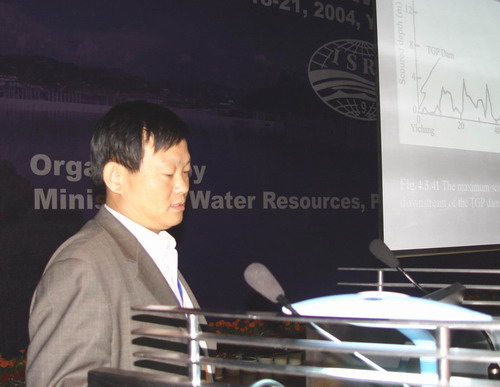
| · |
王兆印作题为《河流与大型工程的相互作用》的主题报告

王兆印(Zhaoyin WANG): INTERACTIONS BETWEEN FLUVIAL SYSTEMS AND LARGE SCALE HYDRO-PROJECTS
Abstract: A large-scale hydro-project is defined as one
or a chain of engineering structures, whose operation may obviously
change the hydrological or hydraulic conditions of the river on which it
is constructed. This paper studies the fluvial processes in the upstream
reaches and tributaries and downstream reaches affected by dams, and the
fluvial impacts of channelization and water diversions. Damming of
rivers not only causes sedimentation in the reservoir but also creates
additional backwater and deposition even further upstream. The Three
Gorges Dam on the Yangtze River may change the upstream reaches from a
braided channel into a single thread channel, and Sanmenxia Dam has
changed the Weihe River from meandering to wandering-meandering.
Downstream reaches of dams experience the following fluvial processes:
(1) channel incision; (2) variation in channel width; (3) reduction in
bank erosion and channel migration; and (4) changes in river patterns.
The study reveals that dams on rivers with low sediment concentration
reduce the channel migration remarkably, but dams on rivers with
hyperconcentrated sediment have little effect on channel migration. Dams
change downstream river patterns from braided to wandering, or from
wandering-braided to wandering-meandering. Defining the channelization
degree as the ratio of the length of the hardened banks to the length of
the channel, we found that if the degree is within the range of 0.8-1.3,
the highest probability of bank failure occurs, because the natural
fluvial process tends to break the constraint of the channelization.
Water diversion has becomes an important stress causing fluvial
processes. The lower Yellow River is a perched river with its riverbed
10 m higher than the surrounding land, which poses a flooding risk but
also provides flowing potential for water diversion to farmland and
cities and towns. At present, more than 10 billion m3 of water is
diverted from the Yellow River, which has caused shrinkage of the
channel and readjustment of the bed profiles. If the quantity of water
diversions along the course is more than the inflow from tributaries,
the riverbed profiles will develop toward a concave profile in the upper
reach and a convex profile in the lower reach.